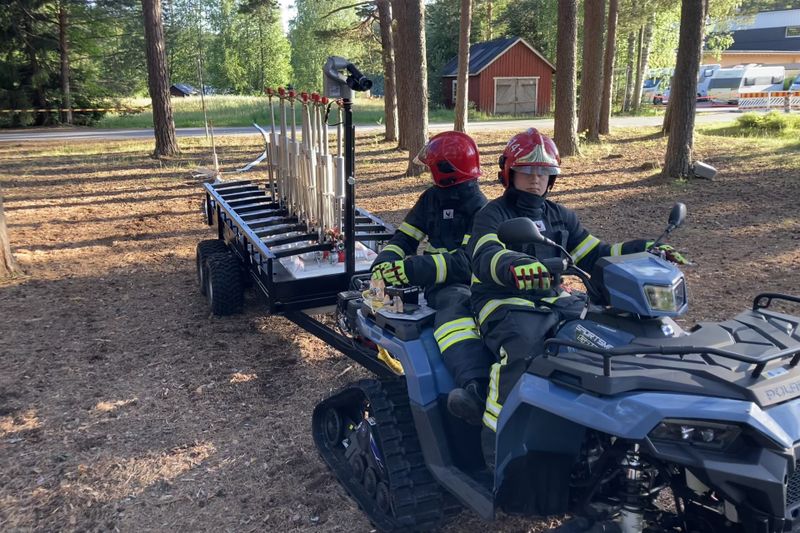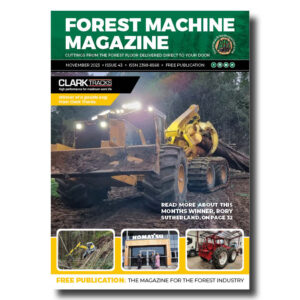Fighting wildfires in an era of climate change: Finnish innovations on the frontlines
From California to the Mediterranean, and now even in the far north of Europe, wildfires are increasingly making headlines. The growing vulnerability of regions once considered low-risk underscores the urgent need for action—and the development of innovative firefighting technologies.
By Nina Garlo-Melkas for www.forest.fi

-
That’s a remarkable amount of work hours for a single machine, the Norcar 600 owned by Erkki Rinne is taken well care of, it even has the original Diesel engine.
-
Kieran Anders is a forestry contractor working in the lake district. His work involves hand cutting and extracting timber using a skidder and tractor-trailer forwarder.
-
It is not possible to eliminate chain shot, but there are simple steps that can be taken to reduce the risk.
-
Arwel takes great pride in the fact that the mill has no waste whatsoever, “the peelings are used for children’s playgrounds, gardens and for farm animals in barns in the winter and the sawdust has multiple uses in gardens and farms as well.
-
Timber hauliers need to encourage young blood in, and also look after the hauliers we have, we need make the sector a safe and positive place to work.
FIND US ON
Related Posts
While wildfires are nothing new, experts warn that climate change has fundamentally altered their frequency, intensity, and the risks they pose to communities worldwide. The number of wildfires is predicted to increase by 50 per cent by the end of the century as a result of the climate crisis and changes in land use, according to a report by the United Nations Environment Programme (UNEP) and the Norwegian environmental centre GRID-Arendal entitled Spreading like Wildfire.

Marko Hassinen, a specialist in forest fire research and an entrepreneur at Fire and Rescue Innovation Finland Ltd., states that fires are igniting more rapidly and spreading to areas that were previously somewhat protected.
“Climate change doesn’t simply mean that it gets warmer and we get more fires,” explains Hassinen.
“It creates longer, hotter, and drier periods, which drastically increase the likelihood of ignition and make wildfires harder to control.”
In countries such as Spain, Portugal, and Greece, summers already bring daily reports of devastating blazes. But northern nations, traditionally shielded by shorter warm seasons and lush greenery, are now also experiencing extended dry spells. This means the wildfire window is getting longer, and the fires more dangerous, even in places once considered low risk.
“In the future, forest fires may ignite more quickly and spread into areas that were previously relatively safe,” Hassinen explains.
Hose cartridge: a game-changer for firefighting
Hassinen, who holds a doctorate in cybersecurity from the University of Eastern Finland, has worked for over ten years in research and training at the Emergency Services Academy Finland. For the past three years, with support from an ELY centre, a Finnish government agency responsible for regional development and implementing the EU’s regional policy objectives, he has been developing a new potentially groundbreaking forest firefighting system that enables rapid control of large wildfires with a small number of rescue personnel.

At the heart of the system is an “off-road vehicle” with its own water tank and a flat platform for hose reels. The hose reel, designed to be attached to vehicles, allows the hose to be pressurised immediately and water to be drawn from the line while the line is being constructed. This allows firefighting work to continue without interruption, as the tank on the cart can be refilled continuously. The water supply system is provided by the fire department’s tanker or a natural water source.
“Lighter equipment is easier to move and requires fewer personnel, making the method a practical addition to the rescue services’ toolkit,” says Hassinen.
Water wealth: a strategic advantage
In southern European countries, severe forest fires are commonplace, and firefighting often relies on airplanes and helicopters – even specially designed drones. In Finland, natural water resources, such as lakes and rivers, offer a significant advantage, but the terrain is challenging with its abundant biomass reserves.
The system developed by Hassinen is in the trial phase and ready to be customised to the needs of different customers. Its commercial launch is still ahead, but the new system’s unique feature of being pressurised during the hose deployment phase is sure to pique interest.
“Traditionally, two firefighters can lay about 600 meters of hose line per hour, but with the new system, that amount triples, and all the water is available immediately from the first hose.”
More results, fewer personnel
The most significant advantage of the new system relates to the use of human resources.
“When you are actually driving the vehicle and everything else is done automatically, you can carry out effective measures with fewer personnel,” Hassinen emphasises. This is crucial, especially in situations where only a small number of rescuers can reach the scene first.

The forest fire cart is not only used for extinguishing fires but also provides protection for surrounding areas and buildings, as well as for assets such as biochip piles in forest industry plants. Containment lines stop the fire from advancing towards residential areas. However, traditional methods—such as manual construction or bulldozer clearing—are slow and challenging in Nordic terrain, where rugged topography and dense vegetation make the work difficult. This underlines the importance of adopting new technology.
The forest fire cart has also attracted international interest. This innovation demonstrates that new technologies are needed as forest fires increase due to climate change.
“This definitely makes operations much faster than before. It significantly speeds up the entire extinguishing process,” Hassinen sums up.
The search for future solutions continues
This summer’s exceptionally prolonged heatwave in Finland underscored a growing global reality: even regions once considered low-risk are now increasingly vulnerable to fast-spreading wildfires. July 2025 was among the hottest on record, with Finland and Sweden enduring sustained temperatures above 30 °C—conditions that sharply raise ignition risks and place heavy strain on firefighting resources.
Similar patterns appeared worldwide. Southern Europe suffered devastating wildfires in temperatures exceeding 45 °C, burning more than 292,000 hectares and displacing thousands, according to the Global Climate Risks platform. The World Meteorological Organization warns that longer dry seasons and erratic weather are turning manageable fires into landscape-scale disasters. Meanwhile, the UN Economic Commission for Europe stresses that wildfire risk must be integrated into national climate strategies, particularly as countries prepare for COP30 in Brazil.
For Finland, this summer is a clear signal: proactive fire prevention and rapid-response technologies are no longer optional but essential. As climate volatility intensifies, nations must invest in smarter fire fighting systems, better forecasting, and scalable innovations to prevent small fires from growing into global catastrophes.
In addition to ground-based solutions, attention is turning to the skies. In the future, swarms of AI-controlled drones could detect wildfires early, transmit real-time data on their spread, and predict fire behaviour over the next hour or even longer. This approach has also been studied in Finland under the leadership of Eija Honkavaara, Research Professor at the National Land Survey of Finland.

“Finland has a very high level of expertise in key areas. In the FireMan project, we developed methods for detecting fires at an early stage and monitoring their progress. We demonstrated real-time fire detection using a small camera and computer carried by a drone, which shows that Finnish drone research is at the forefront of firefighting internationally,” Honkavaara explains.
According to Honkavaara, the most significant advantage of drones is that they enable digital and scalable solutions for rapid fire detection and situation awareness.
“When a fire is detected at an early stage, it does not have time to grow out of control. The situational awareness allows measures to be targeted where they are most useful.”
The study, which ended at the end of 2024, also utilised a digital twin—a computer model of the real environment—to predict fire behaviour and plan, for example, the placement of firebreaks.
According to Honkavaara, research related to forest fire prevention continues to be active both in Finland and globally. For example, larger drone models are being developed, and in the future, swarms of thousands of small drones could together transport significant amounts of water.
“In Finland, new solutions are being actively developed to improve fire safety, such as preventing the spread of fire. Several domestic companies are involved in the development work, and some of the products have already reached the market.”

Drone development work is also ongoing
“Currently, each drone has its own pilot, but the goal is to increase autonomy and enable the simultaneous use of multiple drones. Challenges also include airspace management, legislation, and remote fire situations where mobile networks do not always work,” Honkavaara explains.
Drones must be able to communicate with each other and transmit information to air traffic control.
“I would estimate that we will be much further along in five years. We are still in the research phase, but through demonstrations and cooperation with companies, applications can be put into practice. More autonomous drone systems will be part of firefighting in the coming years,” Honkavaara says.
Honkavaara emphasises the urgency of development. Forest fires are a global threat: in Europe alone, approximately half a million hectares of forest burned last year.
“Wildfires are increasing as the climate warms and droughts become longer. The risk is growing also in Finland, and huge areas in Southern Europe are already burning every year. Effective, technology-based methods should be adopted as quickly as possible.”
Writer: Nina Garlo-Melkas for www.forest.fi
Sign up for our free monthly newsletter here
Contact forestmachinemagazine@mail.com to get your products and services seen on the world’s largest professional forestry online news network.
#homeoflogging #writtenbyloggersforloggers #loggingallovertheworld
Written by loggers for loggers and dedicated solely to the equipment used in forestry operations.








